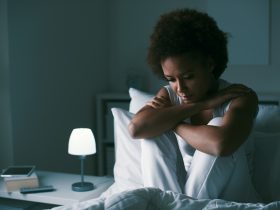Optimizing personal space is an important criterion for mental well-being. Imagine waking up to the gentle embrace of soft sunlight filtering through expansive sliding glass doors, accompanied by the soothing symphony of birdsong and the rhythmic melodies of crashing waves nearby. Sounds blissful, doesn’t it? Indeed, your immediate environment, encompassing elements such as soundscapes, fragrances, illumination, and the tangible objects within your space, exerts a profound influence on your emotional state.
Some experts suggest that the specific attributes that bring us tranquility can be traced back to our evolutionary heritage.
“Consider the sensory experiences our ancestors might have encountered in ancient times. A visually cluttered grassland or savannah would hinder their ability to detect approaching threats, leading to heightened tension,” elucidates Dr. Sally Augustin, a practicing environmental and design psychologist and the principal at Design With Science.
Remarkably, contemporary humans still tend to respond similarly to visually cluttered settings, according to Dr. Augustin. A study published in 2009 in the Personality and Social Psychology Bulletin revealed that individuals who characterized their living spaces as cluttered or incomplete were more prone to heightened levels of daytime depressive mood and experienced fewer fluctuations in their cortisol levels during the night—a factor linked to stress and adverse health outcomes.
Yet, the impact extends beyond visual aesthetics alone. Dr. Augustin points out, “All sensory encounters amalgamate within your mind, merging like ingredients to form a cohesive entity that contributes to your emotional reaction to a given environment.”
Your brain seamlessly processes an array of sensory inputs, encompassing sight, sound, scent, touch, and taste, which collectively shape your emotional response to your surroundings. Research has demonstrated that this amalgamation can render you more serene, invigorated, or even anxious, as detailed in a review published in April 2023 in the journal Trends in Cognitive Science.
This phenomenon arises from both personal encounters and individual preferences, such as the comforting aroma of jasmine reminiscent of your grandmother’s front porch, evoking nostalgia and cherished memories. Additionally, it stems from inherent biological responses ingrained to safeguard humans in an unpredictable world.
The 2023 review highlights that the scent of one’s romantic partner’s shirt can lead to a reduction in self-reported stress and cortisol levels, likely attributed to the positive associations linked to that scent.
Even infants, who have yet to develop the cognitive faculties required for deliberate sensory-based emotional regulation, exhibit diminished fear responses during stressful situations when exposed to skin-to-skin contact or the familiar scent of their mothers. This suggests the existence of both learned and innate responses to various forms of sensory input and experiences.
In essence, it is indeed feasible to “optimize” your immediate surroundings to curate the desired mood or ambiance.
When an environment is thoughtfully tailored to support mental well-being, Dr. Augustin asserts that the outcomes may encompass enhanced cognitive performance, improved interpersonal relations, and heightened clarity of thought.
- Here’s how you can start.
- Embrace Morning Sunshine by Opening Your Blinds
- To kickstart your day with vitality, one of the most effective actions you can take is to invite natural light indoors. According to Augustin, “Unveil your drapes, position yourself towards the window, and soak in as much natural light as possible.”
Exposing yourself to natural daylight in the early morning helps synchronize your body clock with the natural circadian rhythm, as noted by the Centers for Disease Control and Prevention. This can enhance your morning alertness and contribute to improved sleep at night.
Enhance Illumination in Dim Spaces with Mirrors
If augmenting natural light through additional windows isn’t feasible, there’s a clever alternative: incorporating more mirrors.
Dunford, a design psychologist and the style director at Overstock.com, suggests a swift solution for spaces lacking natural light. “For areas deprived of natural light, consider strategically placing mirrors on walls opposite windows,” she advises. “These mirrors will reflect the outdoor view and capture the incoming sunlight, creating the illusion of a brighter and more spacious environment.”
Craft a Morning Energizer Playlist
“Listening to music you find enjoyable elevates dopamine levels,” explains Alison Hughey, a certified music therapist based in Spartanburg, South Carolina, accredited by the Certification Board for Music Therapists, the sole certifying authority for music therapy. This assertion is backed by research.
Jumpstart your day with a positive vibe by immersing yourself in a playlist brimming with cheerful, lively tunes.
Hughey advises selecting songs that bring a smile to your face, make you want to dance, and maintain a beats per minute (BPM) range between 100 and 130.
BPM signifies the tempo of the music you’re grooving to. A study published in 2016 in Frontiers in Computational Neuroscience found that as BPM increased from 90 to 150, listeners experienced heightened positive emotions such as “happiness” and “surprise,” while feelings of “sadness” decreased.
However, it’s crucial to strike a balance, as excessively high BPMs can trigger elevated rates of “tension,” leading to a more stressful or less enjoyable experience. Therefore, a moderately brisk BPM range is ideal for kicking off your day on the right note.
Bear in mind that musical taste varies widely, so curate your playlist with care, selecting music that genuinely resonates with you, rather than relying on a generic “happy” or “morning” playlist from an app.
Declutter Your Surroundings
That ever-growing stack of unsorted mail or the chaotic mishmash of your children’s schoolwork, toys, and laundry accumulating in your space might be more distracting than you realize. According to Dunford, “Clutter has the potential to induce tension and distraction, triggering primitive survival instincts reminiscent of our earliest ancestors, akin to the instinct to scan the treeline or forest for potential threats.” A study published in 2018 in Infant Behavior and Development even found that toddlers exposed to fewer toys engaged in longer play sessions and exhibited greater creativity compared to those surrounded by an abundance of toys. This implies that a less cluttered environment fosters enhanced concentration and creativity.
Decluttering holds particular significance in areas designated for relaxation or focused work, such as your bedroom or home office.
Admittedly, staying on top of clutter can be a challenge, but establishing and adhering to an organizational system to combat it can be immensely beneficial. Dunford recommends minimizing eye-level clutter by utilizing desktop organizers, cabinets that can conveniently fit under a desk, and adjacent wall storage. As items arrive, promptly file them into their designated storage areas and make a habit of regularly sorting through and discarding accumulated clutter.
Infuse Your Bedroom with Lavender Aromatherapy
Certain scents possess the remarkable capacity to influence us on a profound, psychological level, inciting distinct responses. According to Dunford, “Scent is intrinsically intertwined with memory since odors are processed in the same cerebral region where memories are stored” (a phenomenon substantiated by research). This signifies that you can harness the power of scents that resonate with you to craft an immersive olfactory environment that promotes relaxation and uplifts your mood.
Specific fragrances have been subject to scientific scrutiny for their aptitude to induce physical reactions, and lavender, in particular, is renowned for its efficacy in facilitating nighttime unwinding. This holds true, especially if you encounter sleep difficulties or contend with medical conditions that can impact sleep quality, such as depression, cancer, or cardiac ailments, as documented in a comprehensive review. “Scientific evidence underscores lavender’s calming attributes. Place a lavender sachet beneath your pillow, allowing its fragrance to accompany you into slumber,” recommends Augustin.
Revamp Your Lighting Scheme
Modifying your lighting can significantly influence the ambiance of a room. If your goal is to cultivate a soothing atmosphere, Amy Bloomer, a professional organizer and the proprietor of the design firm Let Your Space Bloom (holding a master’s degree in organizational psychology from Columbia University in New York City), recommends opting for several smaller light sources rather than relying on a single, intense overhead light.
Bloomer proposes incorporating elements like candles, table and floor lamps, or even sconces and chandeliers to introduce layered lighting. This indirect lighting approach has demonstrated its potential to alleviate negative moods, as corroborated by prior research.
Opt for Warmer-Toned Light Bulbs
While enhancing your lighting setup, consider swapping out cool-toned light bulbs for warmer alternatives, especially in areas where relaxation or a convivial atmosphere is desired. According to Dunford, “We tend to engage in more intimate conversations and are more inclined to share personal thoughts under warmer lighting conditions. It induces a sense of relaxation and enhances our physical appearance,” she notes. To harness these effects, Dunford suggests seeking bulbs with a color temperature of around 2700 kelvin (a recommendation supported by the previously mentioned research review).
Invigorate Your Space with Lemon Fragrance
While lavender can help you unwind, the scent of lemon can have an uplifting effect. Augustin highlights that lemons have been linked to enhanced cognitive performance, supported by research, making them an ideal aroma to diffuse in your home office.
A study published in 2020 in Building and Environment examined the mood and learning performance of college students exposed to three scents associated with improved cognitive performance: lemon, peppermint, and rosemary. Lemon emerged as the most favored scent and also resulted in higher scores on memory-related tasks. Additionally, the research suggests that improved performance is partially linked to individual scent preferences. Therefore, if you’re not particularly fond of lemon, experimenting with peppermint or rosemary might yield similar benefits.
Embrace Soft, Natural Colors
Color preferences vary widely among individuals, yet the emotional responses elicited by specific colors seem to be rooted in evolution and the natural world. Augustin encourages contemplation of a tranquil spring day in a meadow, complete with gentle breezes, singing birds, and radiant sunshine. The colors found in such an environment, characterized by their subdued saturation, elicit positive emotional responses.
A study published in 2018 in Psychological Research reveals that an individual’s emotional reaction to color is influenced by factors like saturation, hue, and brightness. Less saturated colors are associated with lower emotional arousal (indicative of a calmer state) compared to brighter or more intensely saturated colors.
Thus, if you aim to create an environment through lighting that instills a sense of serenity and uplifts the spirit, consider incorporating soft shades of green, blue, yellow, and white into your space.
Infuse Creativity into Your Home Office with Green Hues
One of the most frequently asked questions directed at Augustin revolves around choosing the ideal paint color for a home office. Surprisingly, there is a “correct” answer: green.
Research has demonstrated that gazing at various shades of green enhances visual creativity, as noted by Augustin. “And that can be advantageous during work,” she emphasizes. For those who might not favor green, consider incorporating natural greens into your office in other ways—such as by adding plants, positioning windows to offer glimpses of trees and grass, or displaying images of landscapes.
Revitalize Your Space with Vibrant Colors
In areas where you seek an invigorating atmosphere—such as a home gym, kitchen, or children’s playroom—opt for bold, saturated colors. Dunford suggests, “Colors with higher saturation and warmth will infuse more energy into a space. The greater contrast in color, the more energizing the ambiance becomes.”
However, exercise caution when using excessive amounts of red. Dunford adds, “Research indicates that people generally perform worse on cognitive tests when surrounded by the color red. It’s also a stimulating hue that elevates heart rates, triggers rapid breathing, and activates the pituitary gland, your stress response.” These assertions align with additional supporting data.
Enhance Your Office Ambience with Instrumental Music
While it might be tempting to groove to your favorite tracks while working, tunes from artists like Taylor Swift, Def Leppard, Jay Z, or other lyric-heavy hits may not be conducive to meeting looming deadlines. “During work hours, seek out music that you enjoy without lyrics. The steady rhythm provides a sense of security and focus without requiring your brain to process words. Instrumental versions of songs can elevate your mood and productivity,” recommends Hughey. (This recommendation is backed by research.)
Embrace Nature’s Presence with Greenery, Water, and Wooden Elements
A significant portion of environmental psychology highlights the positive effects of immersing oneself in nature. “Potted plants, water features, and wood textures work wonders for mood and cognitive performance. They offer a mental rejuvenation,” explains Augustin. Indeed, there is scientific support for this concept.
Studies have indicated that biophilic design, which involves incorporating natural elements into indoor spaces, is linked to lowered blood pressure, enhanced short-term memory, and increased positive emotions.
These findings are grounded in evolutionary biology—our ancestors would have felt most secure in open spaces near accessible water sources. “Nature sounds, like babbling brooks, rustling leaves, birdsong, and natural lighting, provide immense comfort,” she adds. Therefore, any efforts to recreate that age-old sense of safety and springtime meadow ambiance within your home are likely to foster a calmer and more joyful atmosphere.















Find Us on Socials